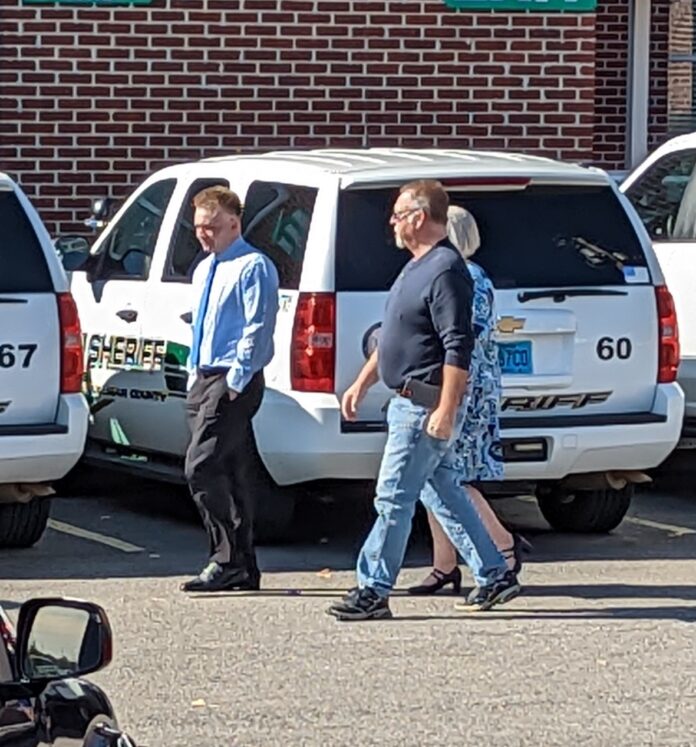
CULLMAN, Ala. – Day three of Cullman man Jason Crawford’s trial in the May 2, 2017, murder of his wife Tiffiney Joy Crawford, began with Cullman County Sheriff’s Office (CCSO) Sgt. Jed Thomas being called to the stand.
Thomas’ body cam video was shown from the night of the incident, in which he can be heard saying, “The pistol was in her hand when I got here.” The gun is identified as a .38 special. Thomas is heard asking the defendant if the victim had a prior history of depression and Jason Crawford responded, “No.” In the video, Thomas is heard stating, “It appears to be a suicide” and “It looks to be a suicide.” At some point in the video, Ronda Crawford, the defendant’s mother, arrived and Thomas is heard speaking to another person asking, “You know it’s Ronda’s daughter-in-law?” referring to the victim.
Thomas confirmed that Ronda Crawford was someone of importance at the CCSO. She served as former Sheriff Mike Rainey’s secretary, and, at the time of Tiffiney Crawford’s death, Ronda Crawford worked in the CCSO’s payroll department. Reporting that the death “was consistent with suicide up to that point” based on the defendant’s story, Thomas noted that it was odd that the deceased’s watch was on her left wrist, typically indicating a person’s non-dominant hand and the gun was found in the victim’s left hand. Usually, a person shoots with their dominant hand but can be trained to use their non-dominant hand.
When CCSO Sheriff Matt Gentry arrived on scene, it was indicated that Thomas was to turn off his body cam recording as is usual protocol when talking to a supervisor, per Thomas.
Second to the stand was Julie Luker, a responding paramedic, who arrived to find the victim on the ground with a member of a local volunteer fire department administering CPR and using an automated external defibrillator (AED). Luker said she assessed the victim and called the on-call physician at Cullman Regional. Luker called the time of death. She noted two gunshot wounds, one to the left cheek by the lip and the other to the left temple.
Third to the stand was Cullman County Coroner Jeremy Kilpatrick, who said he was told there was a single gunshot wound, leading him to initially think the deceased was a victim of suicide. As the investigators were photographing the death scene, Kilpatrick opted to enter the home and speak with Jason Crawford and his parents where he learned the defendant and the deceased had been arguing. Upon noting the second gunshot wound, Kilpatrick said, he called Cullman County District Attorney Wilson Blaylock for authorization for an autopsy due it being “extremely rare for someone to shoot (themselves) in the head two times in a row.” Kilpatrick said the victim’s death “definitely fell under a suspicious death.” On cross examination, Kilpatrick clarified that while extremely rare, a double shot is possible, but improbable.
CCSO Investigator Jared Aaron was called to the stand and said he could not recall if he knew of the defendant’s familial relations at the time. Allen photographed the crime scene and reviewed several of the photographs in court. Photographs of the various areas of the van, the console, dash, passenger floorboard and other areas were shown with varying amounts of the victim’s blood. Entry wounds were noted on the left cheek and left temple and none of the right side.
The gun was photographed on the floorboard where it had fallen from the victim’s left hand when she was checked for a pulse. Tiffiney Crawford’s gun holster and her .38 special, which Aaron had seized from the vehicle and sealed, were entered into evidence in court.
Aaron spoke of the conversation he had with Kilpatrick about an autopsy which Aaron recommended due to the victim being a female and the two gunshot wounds. He stated that in his experience as an investigator it was rare for a woman to use a gun as a method of suicide and the likelihood of two shots was rare. He was asked why the van was not seized and he said he did not know. He recalled discussing, in the Crawfords’ home, the possibility with another deputy and Sheriff Gentry, and even though it was agreed the death was suspicious, the vehicle was not taken. He was unsure if the Crawford family (Jason or his parents, Chris and Ronda), was present during the discussion. When asked who made the decision to not seize the vehicle, Aaron replied, “I don’t necessarily have an answer.”
On cross examination, Aaron revealed he did not take the clothing of the defendant and stated that knowing the family did not alter his investigation.
During redirect, it was noted that no fingerprints were taken by the CCSO due to the investigation being turned over to the State Bureau of Investigation (SBI). It was also noted that no photos were taken inside the home and that the victim’s gun holster was for a right-handed person.
The Crawford family allegedly discussed covering the vehicle with a tarp to protect the victim’s small children, but Allen said he didn’t recall discussion of cleaning the vehicle. He was asked if the family would have been allowed to keep the vehicle if Ronda Crawford was not employed with the CCSO. When he was quiet, the prosecution said Allen didn’t have to answer.
Alabama Law Enforcement Agency SBI Investigator Joe Parrish testified that he received a verbal request to take over the investigation the day after the victim’s death. Upon learning the van was not seized, he obtained a search warrant only to find the van “was clean” with no visible blood. The gun holster which had been found to Tiffiney Crawford’s right at the time of her death has been moved to the back hatch of the van. Statements were taken from the defendant and the victim’s friends.
During his interview, Jason Crawford told investigators he was crushed to learn of his wife’s affair hours before her death and “it ripped his heart out.” The defendant, in his statement, acknowledged a heated conversation by the victim’s van where he said he berated her, calling her an unfit mother. He continued that he “made her cry, cussed her and made her feel pretty low.” He stated he went into the home to retrieve his wife’s work smock and threw it off the porch toward her and did the same with her work pants. The defendant stated the victim was crying so hard she was wiping her eyes and nose on her shirt. He went on to say he went inside, heard a pop, a scream and a pop then went outside, looked inside the vehicle at his wife and went back inside.
Questioned by the defense, Allen said that the defendant reported moving his wife’s body to check for a pulse while on the phone with 911, but he didn’t know where to check for a pulse. The defendant stated that he was careful as he didn’t want to touch the gun.
The victim’s journal was submitted into evidence where she wrote on May 2, 2017, “I’m struggling…” and that, when people ask if she is OK, she responds, “I tell them I am for the most part.” The same journal entry, on the day the victim died, also read, “I’ve always been a positive person overall” and “My faith in God helps me stay positive.”
Allen said that, based on the evidence and investigation, he couldn’t figure out a reason Tiffiney Crawford’s death could be suicide.
Last on the stand on Wednesday was Licensed Professional Counselor Laura Doss who saw the victim on May 1, the day before her death, for an intake appointment. The comprehensive screening is performed to establish the patient’s mental health status and if the patient is a threat to themselves or others. Doss determined that the victim was not suicidal the day before her passing. Doss reported Tiffiney Crawford had a calm demeanor and that she stated she was unhappy in her marriage due to her husband’s laziness, apathy and nonparticipation in the marriage.
The trial will resume Thursday morning.
Copyright 2022 Humble Roots, LLC. All Rights Reserved.

























